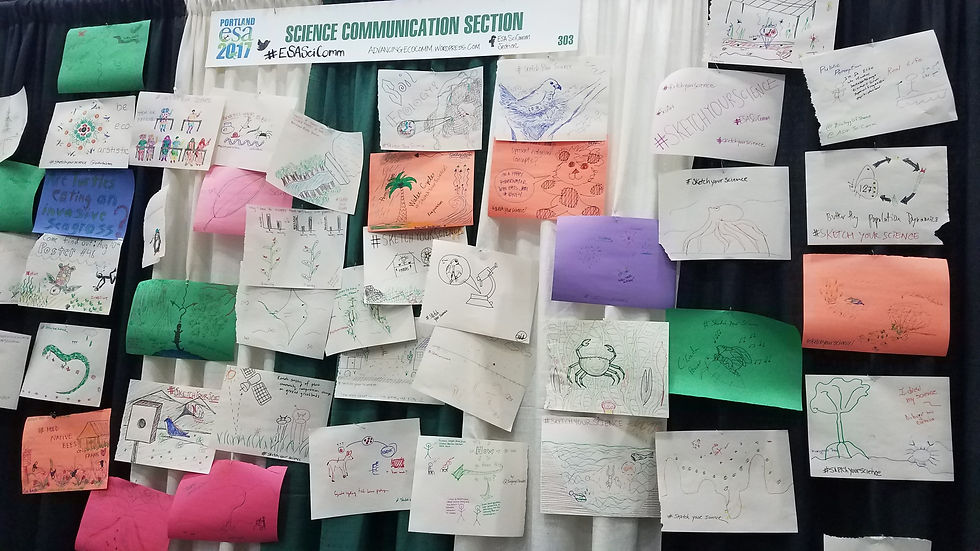
#sketchyourscience at #ESA100 settled it. This will be an #ESASciComm tradition for years to come! pic.twitter.com/Ta8YIVo5BZ — CommNatural/BGMerkle (@commnatural) August 17, 2015
I’m a co-founder of the Ecological Society of America’s new Science Communication Section (#ESASciComm), so I am in a great position to infuse #sciart into #scicomm at ESA. I’ve done so with pleasure in scicomm workshops the past two years.
This year, at ESA’s annual conference/meeting (#ESA100) our section had a booth at which we encouraged folks to sketch their science.
We were blown away by how many people enthusiastically did so.
I’ve put together a Storify (basically a blog post of tweets culled from everyone who was tweeting at #ESA100) that curates twitter activity related to#sketchyourscience and #sciart. Images are interspersed with twitter quotes and tweets about data pointing to myriad benefits of sketching, doodling, etc., for research, learning, and engagement.
Quick! Come to the #esascicomm booth & #sketchyourscience with Dr. J anet Morrison & her undergrad lab! #ESA100 pic.twitter.com/1TgaDnUci4 — CommNatural/BGMerkle (@commnatural) August 13, 2015
A few interesting themes emerged as I pulled all this together:
SciArt
A lot of ESA members (@ESA_org) are interested in #sciart, as evidenced by a phenomenal music and animated video plenary session, several art-related workshops, and massive enthusiasm for drawing activities at the #ESASciComm and @ESA_NaturalHistory booths.
But, there’s very little twitter activity associated with #sciart, #sketchyourscience, and #ESA100. Clearly, there’s work to be done to bring art into the conversation as a learning, data collection, and engagement tool.
What kind of factors do you think might explain/help explain the disconnect between appreciation and talk of SciArt?
#sketchyourscience at the #ESASciComm booth #ESA100 pic.twitter.com/k3swEelec7 — Emily Rollinson (@katteken) August 10, 2015
Art communicating science
Ecologists are better at distilling their research into a sketch/single visual than the classic “art-science dichotomy” would suggest.
This shouldn’t actually surprise anyone, as I mentioned in a guest post on ESA’s blog last Monday (at the start of the conference) and in this op-ed about why scientists should draw. There are serious scientifically quantified benefits associated with using drawing as a learning, assessment, and communication process.
For situations where presenters (or the organizing body) don’t want photographs taken/shared of presentations, sketching can be a powerful way to a) synthesize information and b) share it on social media.
Image attribution is directly related to sharing science via sketches vs. photos. In both cases, not crediting the image creator (and/or not using the image with permission) is akin to #visualplagarism. If you #sketchyourscience, you’ll have compelling visuals that address that attribution issue – image by you!
And yet, again, we’re not hearing much about SciArt at ESA. Particularly for those of you with an inclination to produce art (not necessary to be an artist!), why not? What keeps you for incorporating your art and science? And if you do it, but don’t talk about it, why not?
How's that for concisely conveying research?! Nice job @pjboynton #ESA100 #ESAscicomm pic.twitter.com/x07Ul5zfhl — Molly Mehling (@mollymehling) August 11, 2015
#sketchyourscience yourself
If drawing know-how is a hurdle, the #ESASciComm Section has produced a SciComm Resources Guide that includes a detailed section I curate (on-going; send your suggestions!) on drawing and science. I also provide ‘sketching for scientists’ trainings for faculty and students, and there are a host of great blogs and books out there that can help you hone your skills.
Scicomm resource guide to eco-communication #ESA100 http://t.co/h6nEbjaq9S pic.twitter.com/Xv5qe0HxIS — Ecological Society (@ESA_org) August 11, 2015
Share the fun!
When you do #sketchyourscience, have fun! And, do share your work (sketches, not just the “perfect” drawings) – more talk of/evidence of SciArt is likely key to increasing its presence/practice.
You can send your sketches directly to me, to the SciComm Section, and/or share via social media. If you share/post online, be sure to include one or more of these hashtags:
SciArt sleuthing: help us solve the attribution mystery
One unexpected aspect of the fabulous volume of sketches generated was that we weren’t totally consistent with how the sketches were annotated and signed. So, we’re in the process of scanning and putting together a gallery of the sketches. If you know you sketched, please let us know what yours looks like. If you’re not quite sure, we’ll be posting that gallery, so you can help us out in a few days.
Ultimately, we’d like to use these sketches, but with attribution!
Comments